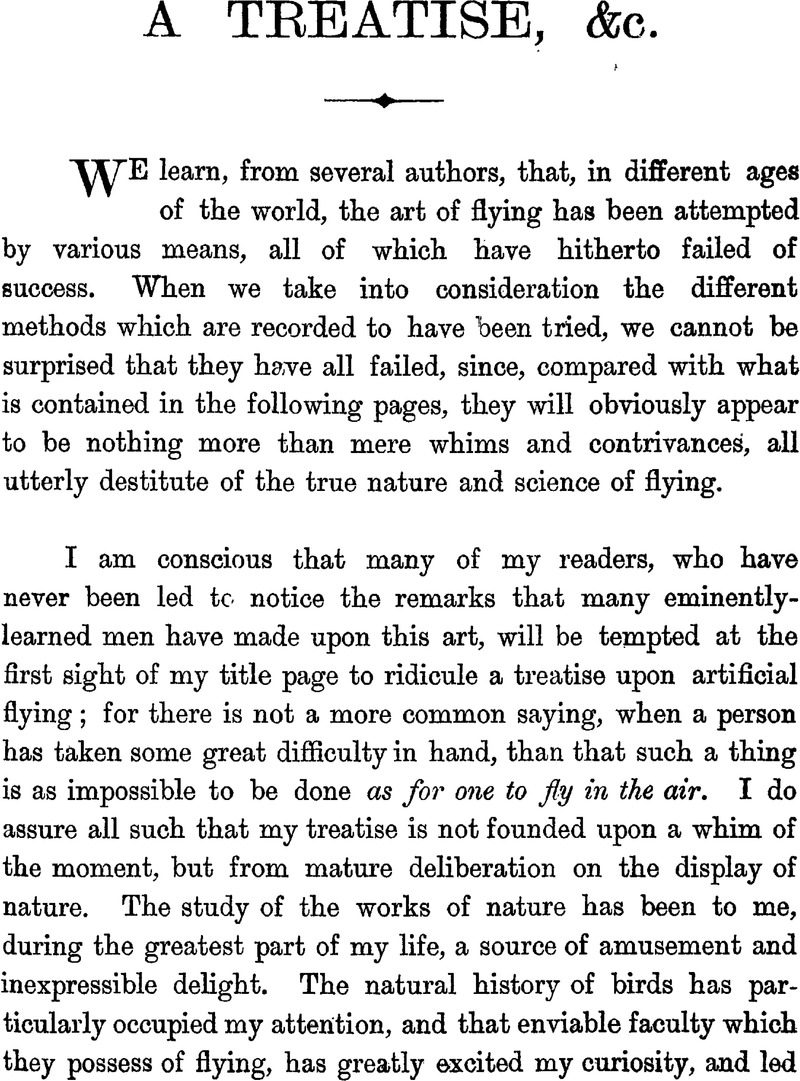No CrossRef data available.
Published online by Cambridge University Press: 08 May 2017

Note on Page 38* The ostrich, in the torrid regions of Africa; the emu, in the extensive plains of Paraguay, in South America, which, standing erect, is about seven feet high, it legs are three feet long, its thighs are nearly as thick as the thighs of a man, it runs so swift that the fleetest dogs are foiled by it ; the cassowary and the dodo, in the Molucca Islands ; and the penguins, in the Straits of Magellan and the South Sea Islands. All these birds are as utterly incapable of flying as a man, none of them being provided with wings for that purpose.
Note on Page 53* M. Degen, a watchmaker of Vienna, has invented a machine by which a person may raise himself into the air. It is formed of two parachutes, of taffeta, which may be folded up or extended at pleasure, and the person who moves them is placed in the centre. M. Degen has made several public experiments, and rose to the height of fifty-four feet, flying, in various directions, with the celerity of a bird. A subscription has been opened at Vienna to enable the inventor to prosecute his discoveries. — Vide the Monthly Magazine for September, 1809.
Note on Page 56* The tail feathers of turkies laid close and parallel to each other, and fast sewed upon eight pieces of strong riband, so as to form the same number of slips, then extended in the wing and well braced, would perhaps answer the purpose much better.
Note on Page 67* I will here take the liberty of communicating a few hints, which I conceive to be of importance to the aërostatic science. Now that we know the true cause of the projectile motion of birds, and I having suggested a plan for producing the same effect by artificial means, we may be able to accomplish what Messrs. Roberts, Blanchard, and others attempted to do, but in vain, entirely from their not possessing a knowledge of this mystery of nature. I am alluding to the steerage of balloons, which they endeavoured, with great labour, to attain, by striking a number of oars horizontally against the air ; and if we do but take into consideration that the balloon was constantly flying from the air against which they were striking, it does not seem probable that they could, by such means, produce the effect they aimed at.
But if we make a car from the plan which I have laid down in this treatise, and upon a scale large enough to admit of one of Messrs. Mead and Co.’s new invented revolving steam engines, to move the lever with, we then can work, in a vertical direction, a pair of very large wings, which would produce a projectile force sufficient to impel the balloon forwards in any point of the compass to which we might incline it; and by having a large tail fixed to the car, in an universal joint, we should be able to give it any inclination whatever; and when we have thus effected a perfect steerage to balloons, we shall be able to convey a number of passengers to any place of destination with accuracy and safety. But for this kind of navigation the balloon must be much smaller than usual, and perfectly spherical, and the gas should be kept in such a degree as not to have too great a tendency to ascend—it should be so regulated as to float in equilibrium with the atmosphere; the aëronauts could then keep the machine at a moderate height—from fifty to a hundred feet would be high enough for ordinary sailing, and if it was found to be inclining too much upwards, it might be counteracted by holding the tail in a descending direction. One of Mr. Mead’s patent steam engines can be made with a one horse power, or equal to the strength of eight or ten men, that will not weigh more than eight stone; and will stand in the small space of four feet by two, with the boiler and all the apparatus belonging to it.